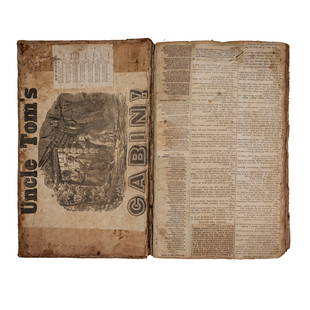
SHIPIBO, STORAGE VESSEL, PERU
Similar Sale History
View More Items in Books, Magazines & Papers
Related Books, Magazines & Papers
More Items in Books, Magazines & Papers
View MoreRecommended Collectibles
View More



Item Details
Description
20th c.
Fired clay, paint
28" x 22" x 22"
Provenance: B.C. Holland, Chicago, Illinois
Allan Stone Collection, New York (acquired from the above in March 1981)
The Shipibo of the Ucayali River, a southern tributary of the Upper Amazon in Peru, produce some of the finest pre-fire, slip-painted earthenware pottery in the world. Their unique tempering process – which took more than ten millennia to perfect - transforms their vessels’ clay paste into a high tensile-strength composite material, allowing Shipibo ceramists to create the largest, thinnest, coil-built, complex-silhouette vessels in the Native Americas. The Shipibo are also notable in that they are one of the few indigenous groups in which the primary artists are women. The patterned pots, known since A.D. 800, are decorated with white or red slip, then burnished before being finally painted with white or black geometric patterns. After being fired, the pots are treated with resin that serves the double purpose of sealing them as well as accentuating the patterns. Patterns have evolved over time: each village has its own patterns and each individual woman her own style, which she passes on to her daughters. There are various types of pots. The largest one is known as Chomo. It is a large pot with a narrowing neck. This pot, which holds between 25 and 50 liters, is normally used for brewing beer. The Shipibo women also make Quëncha and Quënpo bowls – eating and drinking bowls for everyday household use. Finally, the Shipibo-Conibo Indians make a type of pot – Joni – shaped like the Chomo pot, but with a neck shaped like a face. This type of pot is inspired by the ancestral urns and is mainly made for the tourist and art market. The Shipibo and Conibo tribes do not only apply the patterns to their pottery. Textiles, pearl jewelry, and woodcarvings, too, are decorated with these patterns, and they are also used in traditional tribal facial painting and body decoration. Originally these large vessels were made for storing a weak beer drunk during communal ceremonies.
References
DeBoer, W & Lathrap, D. The making and breaking of Shipibo-Conibo ceramics in Kramer, Carol, Ethnoarchaeology: implications of ethnography for archeology, pp. 102-138, Ganteaume, Cécile R. Infinity of Nations: Art and History in the Collections of the National Museum of the American Indian. Smithsonian, 2010 Holstebro Kunstmuseum, Non-Western Collection http://www.holstebrokunstmuseum.dk/en/collection/non-western-collection/shipibo-and-conibo-pottery.aspx Roe, Peter G. Marginal men: Male artists among the Shipibo Indians of Peru, Anthropologica, Vol. 21, 1979, pp. 189–221
Fired clay, paint
28" x 22" x 22"
Provenance: B.C. Holland, Chicago, Illinois
Allan Stone Collection, New York (acquired from the above in March 1981)
The Shipibo of the Ucayali River, a southern tributary of the Upper Amazon in Peru, produce some of the finest pre-fire, slip-painted earthenware pottery in the world. Their unique tempering process – which took more than ten millennia to perfect - transforms their vessels’ clay paste into a high tensile-strength composite material, allowing Shipibo ceramists to create the largest, thinnest, coil-built, complex-silhouette vessels in the Native Americas. The Shipibo are also notable in that they are one of the few indigenous groups in which the primary artists are women. The patterned pots, known since A.D. 800, are decorated with white or red slip, then burnished before being finally painted with white or black geometric patterns. After being fired, the pots are treated with resin that serves the double purpose of sealing them as well as accentuating the patterns. Patterns have evolved over time: each village has its own patterns and each individual woman her own style, which she passes on to her daughters. There are various types of pots. The largest one is known as Chomo. It is a large pot with a narrowing neck. This pot, which holds between 25 and 50 liters, is normally used for brewing beer. The Shipibo women also make Quëncha and Quënpo bowls – eating and drinking bowls for everyday household use. Finally, the Shipibo-Conibo Indians make a type of pot – Joni – shaped like the Chomo pot, but with a neck shaped like a face. This type of pot is inspired by the ancestral urns and is mainly made for the tourist and art market. The Shipibo and Conibo tribes do not only apply the patterns to their pottery. Textiles, pearl jewelry, and woodcarvings, too, are decorated with these patterns, and they are also used in traditional tribal facial painting and body decoration. Originally these large vessels were made for storing a weak beer drunk during communal ceremonies.
References
DeBoer, W & Lathrap, D. The making and breaking of Shipibo-Conibo ceramics in Kramer, Carol, Ethnoarchaeology: implications of ethnography for archeology, pp. 102-138, Ganteaume, Cécile R. Infinity of Nations: Art and History in the Collections of the National Museum of the American Indian. Smithsonian, 2010 Holstebro Kunstmuseum, Non-Western Collection http://www.holstebrokunstmuseum.dk/en/collection/non-western-collection/shipibo-and-conibo-pottery.aspx Roe, Peter G. Marginal men: Male artists among the Shipibo Indians of Peru, Anthropologica, Vol. 21, 1979, pp. 189–221
Condition
Some abrasions with surface loss, no cracks or apparent repairs or breaks. One repaired U shaped crack 10 in length. Several fire clouds. Condition reports are rendered as specialist opinion by the staff of the Auction House and/or independent consultants and not as statements of fact. We do not guarantee the content of written or verbal condition reports. The absence of a condition report does not imply that there are no condition issues with the lot. ?? ?Please call us at (609) 397-9374 or e-mail info@ragoarts.com with any questions about this lot at least 24 hours prior to auction.?
Buyer's Premium
- 30%
SHIPIBO, STORAGE VESSEL, PERU
Estimate $400 - $600
12 bidders are watching this item.
Shipping & Pickup Options
Item located in Lambertville, NJ, usSee Policy for Shipping
Payment

Related Searches
TOP

























![Vega's account of Conquest of Peru 1658: Heading: Author: Vega, Garcilaso de la Title: Histoire des guerres civiles des Espagnols dans les Indes; cause?es par les souslevemens des Picarres et des Almagres... [bound with] Suitte des guerres](https://p1.liveauctioneers.com/642/258705/134603089_1_x.jpg?height=310&quality=70&version=1661362286)





![Spanish join Condamine, explore South America: Heading: Author: Ulloa, Antonio de, & Jorge Juan y Santacilla Title: Relacion historica del viage a la America Meridional... [with] Observacions astronomica y phisicas...del Peru Place Published: Mad](https://p1.liveauctioneers.com/642/258705/134603088_1_x.jpg?height=310&quality=70&version=1661362286)








































![George Washington Signed Discharge: Partly printed discharge document signed by George Washington, as Commander in Chief of the Armies of the United States. Newburgh, [New York], 4 January 1783. 1 page, ## x ## in. Undersigned by Washin](https://p1.liveauctioneers.com/7226/322253/173251475_1_x.jpg?height=310&quality=70&version=1710004847)



![[Ambrotype] Texas Confederate Soldier: Sixth plate ambrotype. Full leatherette case. Portrait of a possible Texas Confederate soldier. A silver star device was used to pin up the brim of his light-toned headgear, a look often seen in image](https://p1.liveauctioneers.com/7226/322253/173251509_1_x.jpg?height=310&quality=70&version=1710004847)


